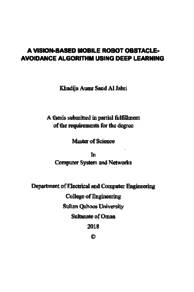Document
A vision-based mobile robot obstacle-avoidance algorithm using deep learning
Publisher
Sultan Qaboos University
Gregorian
2018
Language
English
Subject
English abstract
Navigation is one of the most important parts in designing and developing any intelligent vehicle. Staying operational while avoiding collisions and staying within safe conditions are priorities in autonomous vehicles. Obstacle avoidance is the core problem for mobile robots. Its objective is to allow mobile robots to explore an unknown environment without colliding with objects. The most classical approaches used in this direction relied on geometric models where local cost-maps are constructed. These methods involve low-level intelligence, without any perception process. Deep learning has been rapidly growing in recent years obtaining excellent results for many computer vision applications, such as image classification and object detection. One aspect for the increased popularity of deep learning is the ability to mitigate the need for handcrafted features. Inspired by the advantages of the hierarchical feature extraction of deep learning, this work investigates the development of a Convolutional Neural Network (CNN) algorithm to solve the problem of the mobile robot obstacle avoidance in an indoor environment. The algorithm takes raw images and robot orientation as input and generates control commands as network output. Control commands include go-straight-forward, turn-full-left, turn-half-left, turn-full-right, and turn-half-right. A dataset is collected which contains depth images (RGBD) and robot orientation data obtained by an Inertial Measurement Unit (IMU). In addition, the performance of the algorithm in terms of training options, hyperparameters, and output precision is evaluated and recommendations are provided accordingly. The final results show that the accuracy can be improved by including the robot orientation in the dataset, increasing the size of data, and tuning the network's hyperparameters. The CNN algorithm has shown great potential to get high path classification accuracy for obstacle avoidance for mobile robots.
Member of
Resource URL
Arabic abstract
يعد التنقل أحد أهم الأجزاء في تصميم وتطوير أي سيارة ذكية. البقاء في العمل مع تجنب الاصطدامات والبقاء في ظل ظروف آمنة هي أهم الأولويات في المركبات ذاتية التحكم. تجنب العقبة هي المشكلة الأساسية للروبوتات المتنقلة. الهدف منها هو السماح للروبوتات المتنقلة باستكشاف بيئة مجهولة دون الاصطدام بالأشياء. اعتمدت أكثر الأساليب التقليدية المستخدمة في هذا المجال على النماذج الهندسية حيث يتم بناء خرائط التكلفة المحلية. تعتبر هذه الأساليب ذات نكاء منخفض المستوي ، دون أي عملية إدراك. التعلم العميق نمي بسرعة في السنوات الأخيرة وذلك لحصوله على نتائج ممتازة للعديد من تطبيقات رؤية الكمبيوتر ، مثل تصنيف الصور وكشف الكائنات. أحد الجوانب التي أدت إلى زيادة شعبية التعلم العميق هو القدرة على التخفيف من الحاجة للميزات اليدوية. يستلهم هذا العمل ، المستوحى من مزايا الميزة التعلمية الهرمية للتعلم العميق ، تطوير خوارزمية شبكة عصبية تلافيفية (CNN) لحل مشكلة تفادي عقبة الروبوتات المتنقلة في البيئات الداخلية. تأخذ الخوارزمية الصور الأولية واتجاه الروبوت كمدخل وتولد أوامر التحكم كخرج للشبكة. تتضمن أوامر التحكم: السير مباشرة للأمام، الانعطاف الكلي لليسار، الانعطاف الجزئي لليسار، الانعطاف الكلي لليمين، والانعطاف الجزئي لليمين. يتم جمع مجموعة بيانات تحتوي على صور عمق (RGBD وبيانات اتجاهات الروبوت التي يتم الحصول عليها عن طريق وحدة القياس بالقصور الذاتي .(IMU) بالإضافة إلى ذلك ، يتم تقييم أداء الخوارزمية من حيث خيارات التدريب ، والمعلمات، ودقة الإخراج ، ويتم تقديم التوصيات وفقا لذلك. أظهرت النتائج النهائية أنه يمكن تحسين الدقة من خلال تضمين اتجاه الروبوت في مجموعة البيانات ، وزيادة حجم البيانات ، وضبط المعلمات للشبكة. لقد أظهرت خوارزمية (CNN) إمكانات كبيرة للحصول على دقة تصنيف مسار عالية لتفادي العوائق الروبوتات المتنقلة.
Category
Theses and Dissertations

